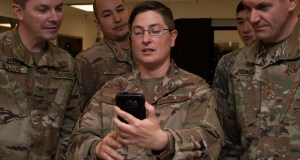The tough tech that guides U.S. Special Forces to the ground


Military parachutists often perform under nightfall. (Pixabay)
Imagine trying to drive anywhere with nothing more than a compass and a rudimentary GPS. Now, instead of driving, imagine trying to jump out of an airplane to reach your destination, adding only a parachute to your array of tools — at night, in a storm.
Until recently, this has been the reality for military parachuters. Special forces operations that require a parachute landing look far different than your average skydiver. Troops often jump from heights of 25,000 feet (more than twice the standard altitude for civilian skydivers), spending an extra 30 to 60 minutes falling and traversing between 30 and 50 miles, to land at their mission’s destination.
To reduce the difficulty and risk associated with such jumps, an Ohio-based company has created a navigation system that military parachutists can use to guide themselves to their exact landing targets without having to rely on archaic equipment and highly-educated guesswork.
Airborne Systems’ Pilot software measures data like wind speed, altitude and distance from the target, and is installed on a ruggedized tablet that’s attached to the soldier’s parachute. The company uses Panasonic tablets due to their light weight and ability to function in the harsh high-altitude, low-pressure, low-visibility situations parachutists often find themselves in.
“[The tablets] have a good display size — not too big, not too small,” said Vincent Mignot, a parachute engineer at Airborne. “[The tablets] cannot be too big because [troops] are already carrying a lot of equipment — oxygen bottles and masks, armor plates, rucksacks — and they need to be able use the handles if there is a problem with their parachute.”
Mignot said they chose the tablet because it met special military standards, like IP65 and IP68, as well as a display that was visible in both day and night conditions.
“We quickly realized Panasonic was the best — the quality of the screen, resolution and daylight-readability when jumping were all important to us,” said Mignot. “During jumps it can be very bright, and when testing the other devices, we couldn’t see anything on the screen. The Toughpad was easy to read and we were never really able to damage the devices during testing.”
Mignot says Airborne’s software has been deployed in countries where militaries employ parachutists, including with the U.S. Army Special Forces. According to business analytics firm Govini, Airborne’s parent company, TransDigm Group Incorporated, is a subcontractor for Lockheed Martin on a $22.5 million SOCOM Logistical Support contract.
You can see Airborne’s system in action by viewing the video below.
Contact the reporter on this story via email at greg.otto@fedscoop.com, or follow him on Twitter at @gregotto. His OTR and PGP info can be found here. Subscribe to the Daily Scoop for stories like this in your inbox every morning by signing up here: fdscp.com/sign-me-on.






